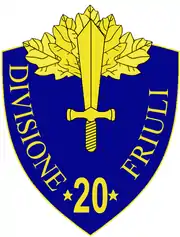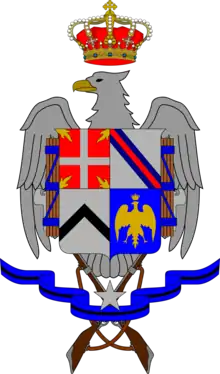20th Infantry Division Friuli
The Infantry Division "Friuli" was a division of the Italian Army active in World War II and during the early days of the Cold War.
| 20th Infantry Division "Friuli" | |
|---|---|
 20th Infantry Division Friuli Insignia | |
| Active | 1939 - 20 September 1944 20th Infantry Division "Friuli" 21 September 1944 - 15 October 1945 Combat Group "Friuli" 16 October 1945 - 15 April 1960 Infantry Division "Friuli" 16 July 2013 - 1 July 2019 Division "Friuli" |
| Country | |
| Branch | Italian Army |
| Type | Infantry |
| Size | Division |
| Garrison/HQ | Florence |
| Nickname(s) | "Friuli" |
| Engagements | World War II |
| Commanders | |
| Current commander | Major General Flaviano Godio |
| Notable commanders | General Giacomo Carboni |
| Insignia | |
| "Friuli" Division Infantry Regiments Collar Insignia |  |
History
1938 to 1943
The 20th Infantry Division "Friuli" was formed on 24 August 1939 by renaming the existing 20th Infantry Division "Curtatone e Montanara". The division was immediately split to raise the 44th Infantry Division "Cremona". It was a reserve force in Valle Germanasca and Pellice valleys during the Italian invasion of southern France in June, 1940. From the beginning of April, 1941, it took part in the Invasion of Yugoslavia in 1941 as part of the Italian VI Corps. The "Friuli" division was tasked to advance to the Gorenja Vas, Gorenja Vas–Poljane area. It opened fire 6 April 1941, and entered Yugoslavia 11 April 1941.[1] It reached Municipality of Loška Dolina and Municipality of Loški Potok 12 April 1941. The fighting ceased 18 April 1941, and 5 May 1941, the "Friuli" division was ordered back to Italy. When Italy and Germany occupied Vichy France after the Allied landings in French North Africa, the division was ordered to northern Corsica on 8 November 1942 to occupy the island, completing the transfer by 20 November 1942, while the 44th Infantry Division "Cremona" occupied Southern Corsica.[2] From 8 September 1943, to 4 October 1943, it fought Germans on Corsica, with prominent battles occurring at Teghime, Bastia and Casamozza. Afterward, the "Friuli" division was transferred to Sardinia to perform security duties.
Order of Battle

As of its deployment to Corsica in 1942:[2][3][4]
- 87th Infantry Regiment "Friuli" [5][6]
- 87th Command Company
- 1st Infantry Battalion
- 2nd Infantry Battalion
- 3rd Infantry Battalion
- 87th Mortar Company, with 81mm Mortars
- 87th Accompanying Arms Company, with 65/17 Field Guns
- 88th Infantry Regiment "Friuli"[7][8]
- 88th Command Company
- 4th Infantry Battalion
- 5th Infantry Battalion
- 6th Infantry Battalion
- 88th Mortar Company, with 81mm Mortars
- 88th Accompanying Arms Company, with 65/17 Field Guns
- 35th Artillery Regiment "Friuli"[9]
- 1st Artillery Group, with 100/17 Field Cannons
- 2nd Artillery Group, with 75/27 Field Cannons
- 3rd Artillery Group, with 75/18 Field Cannons
- 4th Artillery Group, with 75/18 Field Cannons
- 5th Anti-Aircraft Group
- 35th Anti-Aircraft Battery, with 20 mm Anti-Aircraft Guns
- 320th Anti-Aircraft Battery, with 20 mm Anti-Aircraft Guns
- 356th Anti-Aircraft Battery, with 20 mm Anti-Aircraft Guns
- 88th CCNN Legion
- 88th CCNN Battalion "Costanza Ciano"
- 96th CCNN Battalion "Petrarca"
- 20th Mortar Battalion, with 81mm Mortars
- 20th Engineer Battalion
- 52nd Pioneer Company
- 20th Signal Company
- 20th Chemical Company
- 20th Anti-Tank Company, with 47/32 Anti-Tank Guns
- 26th Medical Company
- 81st Field Hospital
- 82nd Field Hospital
- 83rd Field Hospital
- 491st Field Hospital
- 23rd Heavy Motor Transport Section
- 13th Supply Section
- 19th Bakery Section
- 58th Carabinieri Section
- 59th Carabinieri Section
- 60th Carabinieri Section
- 79th Field Post Office
Attached units in Corsica:
Commanders
- General Vittorio Sogno
- General Vito Ferrari
- General Giacomo Carboni[12]
- General Ettore Cotronei
- General Ugo De Lorenzis
- General Bartolomeo Pedrotti [2]
1943 to 1945
After the armistice between Italy and the Allies on 3 September 1943 the division in conjunction with the 44 Infantry Division "Cremona" and French Partisans engaged in heavy combat with the German Sturmbrigade Reichsführer SS and 90th Panzergrenadier Division and the Italian 12 Parachute Battalion of the 184 Parachute Regiment,[13] which came from Sardinia and retreated through Corsica towards the harbor of Bastia in the islands north. On 13 September elements of the Free French 4th Moroccan Mountain Division were landed in Ajaccio to support the Italian efforts to stop the 30,000 retreating German troops. But during the night of 3 to 4 October the last German units were evacuated from Bastia leaving behind 700 dead and 350 POW's. After the end of operations on Corsica the division was sent as garrison unit to Sardinia. On 24 November the 88th CCNN Legion was renamed as 387th Infantry Regiment "Friuli".
In July 1944 the division was transferred to San Giorgio del Sannio on the Italian peninsula. On 20 August 1944, the third battalions in the 87th and 88th Infantry regiments were replaced by two Granatieri di Sardegna battalions and on 31 August the 387th Infantry Regiment "Friuli" was disbanded. On 20 September 1944 the division was reorganized as Combat Group "Friuli" and on 5 February 1945, the group entered front as part of the Italian Co-Belligerent Army and replaced the 5th Polish Division "Kresowa" of the II Polish Corps on the Senio river near Brisighella. From there the group advanced with the allied armies to liberate Imola, Castel San Pietro and Bologna.[3]
Cold War
On 15 October 1945, the Combat Group "Friuli" was renamed Infantry Division "Friuli" retaining the 87th and 88th Infantry Regiments as well as the 35th Artillery Regiment; additional units were the 120th Mixed Engineer battalion and some minor support units. Initially the division was based in the city of Bolzano as part of the IV Military Territorial Command, but in 1949 the division moved to Florence and joined the VII Military Territorial Command. There the division was augmented with the 78th Infantry Regiment "Lupi di Toscana", 8th Field Artillery Regiment and 3rd Light Anti-Air Artillery Regiment. Later the 3rd Light Anti-Air Artillery Regiment was replaced by the 2nd Armored Cavalry Regiment "Piemonte Cavalleria".
On 15 April 1960, the division was reduced to brigade, losing its traditional regiments and receiving new units. See Infantry Brigade "Friuli" for the brigade's history since 1960.
Recent history
With the 2013 army reform the Airmobile Brigade "Friuli" was destined to merge with the Cavalry Brigade "Pozzuolo del Friuli" and in preparation the "Friuli" brigade ceded its name on 16 July 2013 to the Division "Friuli" in Florence so that the name and traditions of the Cavalry Brigade "Pozzuolo del Friuli" could be passed to the Airmobile Brigade. The Division "Friuli" commanded of the following brigades in Northern Italy:
 Division "Friuli", in Florence
Division "Friuli", in Florence
However the merger between the two brigades was later canceled and on 1 July 2019 the Division "Friuli" changed its name to Division "Vittorio Veneto" and the name and all traditions of the Friuli were returned to the Airmobile Brigade "Friuli".[14]
Notes
- Footnotes
- An Italian Infantry Division normally consisted of two Infantry Regiments (three Battalions each), an Artillery Regiment, a Mortar Battalion (two companies), an Anti Tank Company, a Blackshirt Legion of two Battalions was sometimes attached. Each Division had only about 7,000 men, The Infantry and Artillery Regiments contained 1,650 men, the Blackshirt Legion 1,200, each company 150 men.[11]
- Citations
- http://www.regioesercito.it/reparti/fanteria/rediv20.htm
- "Regio Esercito - Divisione Friuli". Archived from the original on 14 May 2009. Retrieved 19 April 2009.
- "Esercito Italiano: Gruppo di Combattimento "Friuli" - La storia". Archived from the original on 14 May 2009. Retrieved 19 April 2009.
- Dr. Leo Niehorster. "Divisione Fanteria, 05.04.41". Archived from the original on 14 May 2009. Retrieved 19 April 2009.
- "Archived copy". Archived from the original on 13 December 2004. Retrieved 18 April 2009.CS1 maint: archived copy as title (link)
- http://www.regioesercito.it/reparti/fanteria/rgt/rgt87.htm
- "Archived copy". Archived from the original on 4 March 2011. Retrieved 18 April 2009.CS1 maint: archived copy as title (link)
- http://www.regioesercito.it/reparti/fanteria/rgt/rgt88.htm
- "Archived copy". Archived from the original on 13 December 2004. Retrieved 18 April 2009.CS1 maint: archived copy as title (link)
- Wendal, Marcus. "Italian Army". Axis History. Retrieved 16 April 2009.
- Paoletti, p 170
- "Carboni Giacomo, Lieutenant-General". Generals.dk. Steen Ammentorp.
- "Esercito Italiano: Divisione "NEMBO" (184^)". Archived from the original on 14 May 2009. Retrieved 19 April 2009.
- "La Friuli diventa Vittorio Veneto". Italian Army. Retrieved 5 July 2019.
- Macksey, Major Kenneth (1971). Beda Fomm: Classic Victory. Ballentine's Illustrated History of the Violent Century, Battle Book Number 22. Ballantine Books.
- Paoletti, Ciro (2008). A Military History of Italy. Greenwood Publishing Group. ISBN 0-275-98505-9.